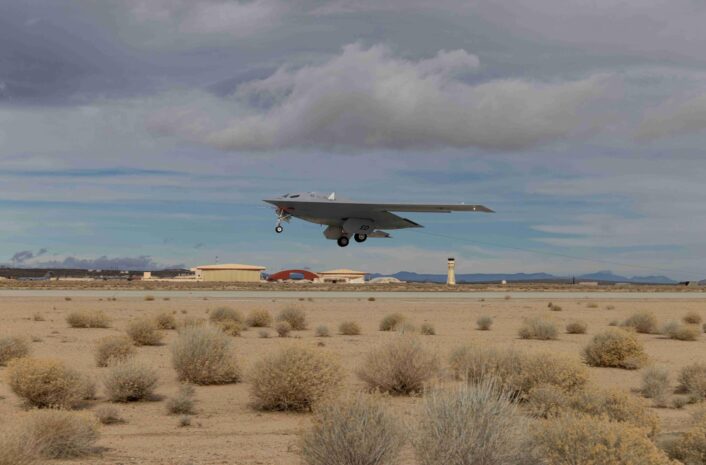The first photo of the B-21 Raider during a test flight was released along with other two new images of the 6th generation bomber.
The U.S. Air Force has released the first photo showing a Northrop Grumman B-21 Raider bomber in flight. The image was taken during one of the test flights of the 6th generation aircraft conducted out of Edwards Air Force Base, by the B-21 Combined Test Force.
As we have recently reported, the new B-21 Raider stealth bomber is currently undergoing flight tests at Edwards Air Force Base in California. However, the U.S. Air Force has remained tight-lipped about the progress since the aircraft’s first flight, and has not released any official photos. The images available so far were taken by photographers who captured the Raider during its initial flight or subsequently flying overhead.
The B-21’s flight tests began at Edwards Air Force Base after its first flight from Air Force Plant 42 in Palmdale on November 10, 2023. Despite the Air Force’s secrecy about the bomber’s status, it acknowledged that the flight test campaign is ongoing. A spokesperson confirmed that the B-21 flew again on January 17, 2024, and subsequent flights were rumored to have occurred in late March and early April, with the a recent confirmed flight on April 4, 2024.
Nice new @usairforce @northropgrumman B-21 Raider image as it undergoes eval with 412th Test Wing at @EdwardsAFB – clearest view yet of auxiliary engine inlet open for take-off pic.twitter.com/TldxZrN6ah
— Guy Norris (@AvWeekGuy) May 22, 2024
B-21 Raider program update
On May 8, 2024, Andrew Hunter, the Air Force’s Service Acquisition Executive, provided a rare update on the B-21’s status during his testimony to the Senate Committee on Armed Services about Air Force modernization. When asked about the air leg of the nuclear triad, which includes the B-21 and the Long-Range Stand-Off nuclear missile, Hunter stated, “We are in the flight test program, the flight test program is proceeding well.” He explained that the testing is effectively helping to understand the platform’s unique characteristics.
Hunter did not go into further details about the flight tests, which are considered highly sensitive. Previously, the Air Force had also indicated it would not disclose specific details about the test program or the number of flights conducted. Nonetheless, Hunter noted that the program is on track and expressed optimism about the results.

“We are working our way through the test objectives that we have for the platform, and I’m encouraged with how that’s progressing,” Hunter said in response to Senator Kelly. He added that significant milestones are expected this year, and he looks forward to providing data on those efforts in the future.
The B-21 program has heavily utilized advanced digital design tools, which Northrop Grumman claims have been crucial in identifying and correcting errors early in the design process. These tools, such as digital twins, computational fluid dynamics (CFD), and simulation environments, allow extensive modeling and testing before physical construction.
Hunter highlighted the digital nature of the B-21’s design, stating that it is significantly more digital than previous aircraft, aiding in achieving the current progress. This digital approach, along with disciplined requirement setting and the use of mature technologies, has contributed to a relatively short timeline in getting the B-21 airborne.
Following the start of flight testing, Northrop Grumman was awarded the contract for the Low-Rate Initial Production of the B-21 Raider. Although the Pentagon did not disclose the contract details, the Air Force had earlier estimated an average unit cost of $692 million at the bomber’s rollout in 2022. Reports suggest the first contract may cover up to 21 aircraft, with six airframes currently in various production stages, including the one already flying, named “Cerberus.”
Recently, U.S. Air Force Chief of Staff Gen. David W. Allvin mentioned that the Air Force might limit the acquisition to the planned 100 B-21 Raiders, as newer technologies could emerge by the time these bombers are built and delivered.
The Raider
The B-21 is a long-range, highly survivable, penetrating strike stealth bomber set to gradually replace the B-1 and B-2 bombers. According to the U.S. Air Force, it will significantly contribute to national security objectives and reassure U.S. allies and partners worldwide.
The B-21 features an open systems architecture, allowing for the rapid integration of advanced technologies and ensuring the aircraft’s effectiveness against evolving threats. It is expected to enter service in the mid-2020s, with at least 100 units planned for production.
The Air Force Rapid Capabilities Office oversees the acquisition program, emphasizing the need to make test aircraft as close to production models as possible. These test aircraft are constructed on the same production line with the same personnel and tools intended for the final production run, enabling a faster transition to mass production.
A public release says the strategy of the AFRCO involves creating test aircraft that are as representative of production models as possible, including mission systems, using the same manufacturing processes and tooling. This method, instead of traditional flight prototypes, facilitates a quicker start to production.
Upon entering service, Ellsworth Air Force Base in South Dakota will be the primary operating base and location of the Formal Training Unit for the B-21. Whiteman AFB in Missouri and Dyess AFB in Texas are the preferred locations for the remaining bases, which will receive the aircraft as they become available.
The B-21 is set to become the cornerstone of the Air Force’s bomber fleet, capable of both conventional and nuclear missions, and will eventually replace the current fleet of B-52Hs, B-2As, and B-1Bs with a new composition of 100 B-21As and 75 B-52Js by the 2030s.









